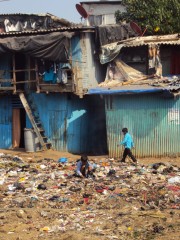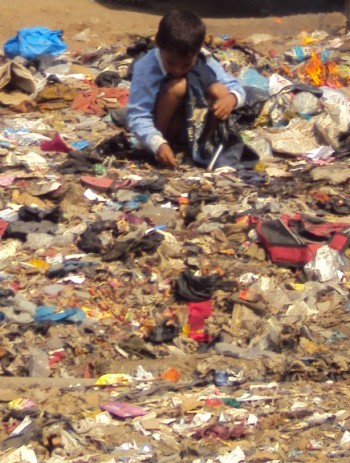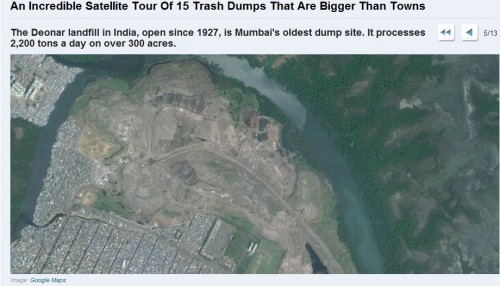09/30/2011
Trash
One of the first questions when I settled down in India: hey, how do we do with the trash? Instructions from my landlady: you put it in the trash can and you leave the can outside your door every evening. And every morning, magic, the trash is empty!!
And sorting out the trash?? No?? Okay okay…
A few months later, looking for my bike downstairs, I saw two women crouching in the trash of 4-5 big containers. So here is how the waste-sorting is done…
In India, nothing gets lost, everything gets transformed; Indians are the kings of recycling (at least at an individual level)...
...You can make someone very happy with a broken pair of shoes that you thought totally useless!! It got me thinking about the current “over-consumption” trends in the developed countries, where it is often easier (and cheaper) to throw then to repair. So now I give a second, even a third chance to broken stuff – this said, I am more and more skeptical as they do repair thing but then they need to do it again and again until you have to throw the thing (and in between you have spent a lot of energy)…
To come back to the trash, I often wondered how it worked in India. How is it picked up? Where does it go? Where are they disposed of?
Better say things the way they are: India is becoming an open-air trash can. You should see Juhu shore before the trash pick-up during some tides… You should see people stopping their cars on bridges to throw garbage bags in the rivers… The consumerist habits are changing very fast in India but there is no education about environment and there is no trash can in the street. At times I try to tell people not to throw their bottle, their pan sachet, their chai cup, in the street. But then where?? There is no trash can because there is hardly any waste management. The story of the snake biting its own tail…
Today in India, every person would generate 0.6 kg of waste per day (which is 3 times less than in the US but because there are so many people, it gives about 720,000 tons of kgs per day). There is “no scientific closure of landfills” and “the system of primary collection of waste is practically nonexistent, as the system of storage of waste at source is yet to be developed.”
“In India, each municipality is responsible for organizing its own waste management in the following areas: waste segregation and storage at the source, primary collection, street sweeping, secondary waste storage, transport of waste, treatment and recycling options for solid waste, final disposal.” “Ideally, trash that makes it to the final disposal stage should be responsibly incinerated or undergo mechanical-biological treatment before being sent to a landfill. But in India, 94% of waste is disposed of unsafely, either burned in an uncontrolled manner, or dumped in untreated landfills, where contaminants can leach into groundwater.”
I was talking earlier about the recycling at the individual level. As a matter of fact, there are in India millions of people who live from picking-up the trash (they are called “rag pickers”) – “in many parts of the developing world collecting and sorting waste “informally” provides a livelihood for large numbers of the urban poor – men and women, with women (and their children) often predominating. The World Bank estimates that 1% of the urban population in developing countries earns a living through scavenging or waste collection and recycling (which would mean about 4 million people in India).” There are trucks but “when sanitation workers transport waste from the bins out of residential areas, they use open trucks or tractors, which they load manually, often without wearing protective gear. Trash often falls out of these trucks during transport, making the process that much more time-consuming, inefficient and unhygienic.” The truck system is such that the waste management can not work without the “rag pickers” who anyway need the job to survive. See more about these people here: Asian Wastepickers.pdf
I have been told twice about a “city” that would have grown on a landfill, like “Smoky Mountain” in Philippines (where 10,000 families live on or next to the landfill (UNEP 1996)) but I could not find anything like this. Of course, every landfill is bordered by the habitations of the people working there. And I imagine that the biggest landfills – like Denoar in Mumbai (2,200 tons daily on 1.2 km2), the 3 landfills of Delhi, Bhalaswa, Okhla et Gazipur (6 tons per day combined) must look like “Smoky Mountains”. I guess I’ll go have a look some day…
However, no need to go very far to see people moving around a trash ground. The exit of the Sea Link in Bandra, the train station of Bandra West… You end up wondering whether people settled on a landfill or created one??
This said, it is difficult for a Westerner to give lessons… It is true that Europeans have a more developed environmental conscience, individually, but their countries just ship their trash to India! “Shipping municipal waste to India is about four times cheaper than recycling it in their own land.” And even if “the Basel Convention on the Transboundary Movement of Hazardous Wastes which came into effect in 1998, bars exports from rich to poor nations of a range of substances known to harm human health and the environment”, Indian authorities are quite flexible (and very corrupted). Once in a while, you hear about “20 containers of trash from French colony Reunion and Greece imported by Sripathi Paper and Boards getting confiscated” (March 2010) but most stories are unheard of…
And then there is Alang, in Gujarat. This site of ship breaking yard is now well-known – as are the working conditions, diminished life span, coastal pollution… Half the world sends their ships there to end their life…
To conclude, from what I could read online, there are worst situation in India but it is quite not great either!
Sources :
http://www.ban.org/ban_news/india_import.html http://www.marineinsight.com/marine/environment/alang-gujarat-the-world%E2%80%99s-biggest-ship-breaking-yard-a-dangerous-environmental-time-bomb/
http://www.marine-marchande.net/Petits_Reportages/Perchoc/Alang/0-Alang.htmlhttp://scrapshipbreaking.com/2011/05/09/alang-gujarat-india/http://www.un.org/esa/dsd/susdevtopics/sdt_pdfs/meetings2... http://earth911.com/news/2009/08/03/trash-planet-india/
http://www.inclusivecities.org/pdfs/Asian%20Wastepickers.pdf
http://www.huffingtonpost.com/2011/04/04/female-fetuses-india_n_844432.html
http://www.nytimes.com/2010/04/23/world/asia/23iht-letter.html
http://www.thehindu.com/todays-paper/tp-features/tp-downtown/article2443400.ece
08:00 Posted in Incredible India! | Permalink | Comments (0) | Tags: india, landfill, dump, garbage, can, rubbish, trash, waste, wastemanagement, recycling, alang, smoky mountains, rag pickers, poverty | ![]() Facebook | |
Facebook | |


















The comments are closed.